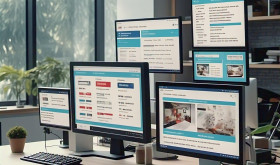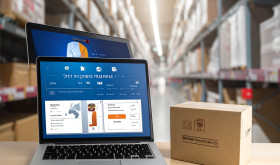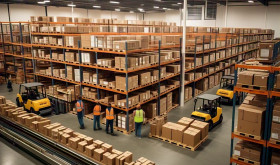
Third-Party Logistics (3PL) providers stand at the heart of today’s supply chain. As companies choose to outsource storage, fulfilment, and transportation, the productivity of logistics partners becomes a key factor in competition. The warehouse management system forms the backbone of this productivity. This digital platform has the job to coordinate storage, inventory, labour, and order execution within a warehouse. For 3PL companies, a robust warehouse management system is now a must-have. It serves as a strategic tool to enable growth, visibility, and customer satisfaction.
Why WMS Matters in 3PL
3PL warehouses must serve many clients across industries, unlike single-enterprise warehouses. Each client might have different service-level agreements, inventory needs, and compliance rules. Managing this variety without automation results in mistakes, holdups, and lost revenue. A warehouse management system solves this by:
- Bringing together control of inventory, locations, and orders.
- Making routine tasks like picking, packing, and restocking happen on their own.
- Providing real-time visibility to both the 3PL operator and its clients.
- Supporting with billing and reports for many customers and contracts.
In a nutshell, a warehouse management system transforms the warehouse from a place that costs money into a platform that adds value to services.
Core Features of a warehouse management system
A modern warehouse management system offers a wide range of features designed for logistics operations. Key capabilities include:
- Inventory Management
This system keeps track of stock at the SKU level across multiple locations. It supports lot control serial numbers, expiry dates, and cycle counting to keep accuracy above 99%.
- Receiving and Put-away
This feature automates inbound processes from Advanced Shipping Notices (ASNs) to labeling. It also has an impact on put-away rules to cut down travel time and make the most of space usage.
- Order Management and Picking
This handles orders from multiple clients, batch picking, wave picking, or zone picking. Linking up with mobile devices and voice-directed systems leads to fewer errors.
- Packing and Shipping
Creates labels, packing slips, and compliance papers. Works with carriers to shop rates and track packages.
- Labor and Resource Management
Monitors how productive workers are and gives out tasks as needed. Helps with work standards, key performance indicators, and reward systems.
- Reporting and Analytics
Shows dashboards that let you see order times, fill rates, and client-specific numbers in real time.
For third-party logistics companies, billing features are key, as they allow charging for storage, handling, and extra services by client.
Benefits of WMS in the 3PL and Logistics Sector
Using a WMS has a positive impact on:
- Accuracy and Reliability: Automated data capture cuts down on picking and shipping mistakes, which boosts service quality.
- Speed and Efficiency: Streamlined workflows shorten cycle times, making it possible to fulfil orders the same day or the next.
- Visibility and Transparency: Customers can see real-time dashboards and inventory reports, which helps build trust.
- Scalability: Multi-tenant design allows new clients to join without needing big system changes.
- Compliance: Keeps tabs on rules for customs bonded warehouses or dangerous goods.
- Cost Control: Better use of space, less wasted labour, and exact billing boost profits. These advantages often make the difference for logistics companies in a packed market.
Integration with Supply Chain Systems
A warehouse management system doesn’t work alone. To add value, it needs to connect with systems before and after it:
- Enterprise Resource Planning (ERP): Syncs financials, procurement, and sales orders.
- Transportation Management System (TMS): Coordinates carrier selection, route optimisation, and freight billing.
- Order Management Systems (OMS): Aligns customer orders with warehouse execution.
- E-commerce Platforms: Provides direct connectivity for online retailers needing fulfillment services.
- IoT and Automation Systems: Connects to RFID gates, conveyors, Autonomous Mobile Robots (AMRs), or Automated Storage and Retrieval Systems (ASRS).
Challenges in Implementing a Warehouse Management System for 3PL
Even with clear advantages, 3PL providers run into several issues when setting up a warehouse management system:
- Complexity of Multi-Client Environments: Each customer needs unique workflows, reports, and billing rules. Setting up the warehouse management system to handle all these different needs is tough.
- High Implementation Costs: Buying licenses, customising the system, and teaching staff how to use it can cost a lot up front.
- Change Management: Moving from doing things by hand to letting a system run things often faces pushback from inside the company.
- Data Accuracy at Launch: Putting wrong master data into a new warehouse management system causes operations to fail.
- Integration Risks: Poorly executed system interfaces cause delays and duplicate work.
To succeed, 3PLs need to pick solutions that can grow and adapt and put effort into careful project management.
Trends Shaping the Future of WMS
The warehouse management system scene keeps changing. Key trends that have an impact on 3PL adoption include:
- Cloud-Based Warehouse Management System
Subscription plans cut initial expenses, make upgrades easier, and offer access from anywhere.
- Artificial Intelligence and Machine Learning
AI helps predict demand, optimise slot placement, and plan workforce needs, shifting operations from reactive to proactive.
- Automation and Robotics Integration
Warehouse management systems now often control AMRs, ASRS, and robot teams, boosting efficiency beyond just software.
- Blockchain and Secure Data Sharing
Creates clear records of transactions among many partners, building more trust in complex supply chains.
- Sustainability Reporting
The warehouse management system now keeps track of energy consumption, carbon output, and waste, aligning logistics to green objectives.
- Customer Self-Service Portals
Customers now expect to access inventory, order status, and billing information in real time without manual assistance.
Case Example: 3PL with Warehouse Management System Adoption
Think about a regional 3PL provider that handles consumer electronics and clothing. Before they started using a warehouse management system, the company depended on spreadsheets and manual methods, which led to 6% error rates and late shipments. After they rolled out a cloud-based warehouse management system with RFID integration:
- Picking accuracy got better, reaching 99.8%.
- Order cycle time went down from 48 hours to less than 12.
- Real-time dashboards gave clients a clear view, which cut down customer service questions by 40%.
- Billing automation captured extra services like kitting and relabeling, which boosted revenue.
The warehouse management system transformed the provider from a company with small profits to a trusted supply chain partner.
Best Practices for 3PL WMS Deployment
Successful projects stick to several key practices:
- Get Stakeholders Involved: Bring in clients, warehouse managers, and IT teams to define what’s needed.
- Pick Flexible Solutions: Choose a WMS that can handle multiple tenants and allows for custom billing.
- Make Data Cleansing a Top Priority: Check that inventory, SKU, and client master data are correct before you migrate them.
- Test Before Full Rollout: Begin with one warehouse or one customer to improve your methods.
- Invest in Training: Provide your team with handheld devices, RF scanners, or voice-picking tools, and teach them how to use them well.
- Plan for Scalability: Think ahead about future automation and new clients.
Taking these steps cuts down on risk and makes sure you get good returns in the long run.
For 3PL and logistics companies, a warehouse management system isn’t just another IT tool anymore—it’s key to staying competitive. It gives you a clear view, boosts productivity, and helps you grow while connecting different parts of the digital supply chain. As online shopping keeps growing, customers want more, and there’s pressure to automate things, warehouse management systems will play an even bigger role. Companies that put money into flexible, future-proof warehouse management systems set themselves up as more than just storage managers. They become key players in helping their clients succeed.










